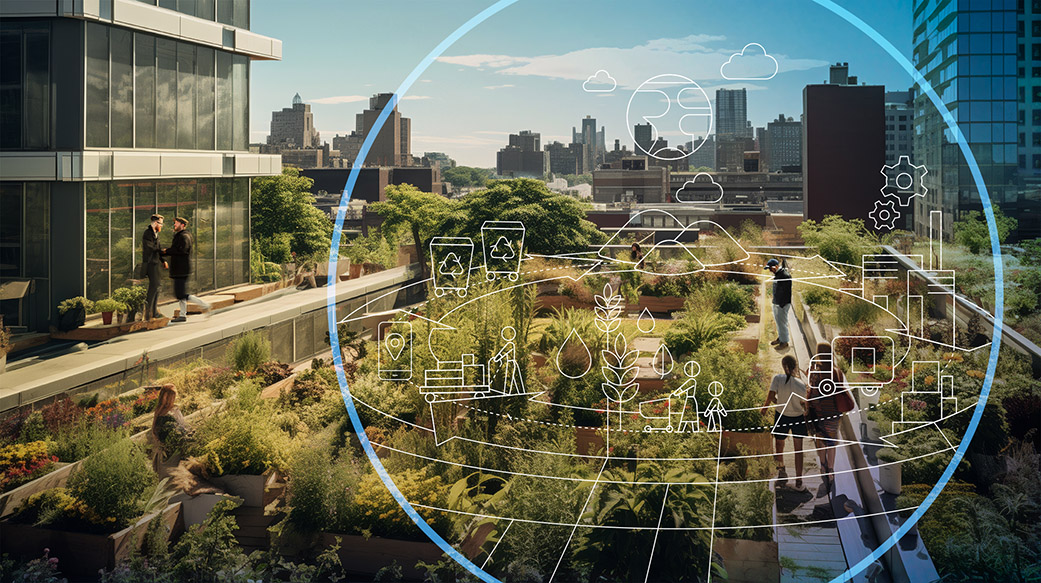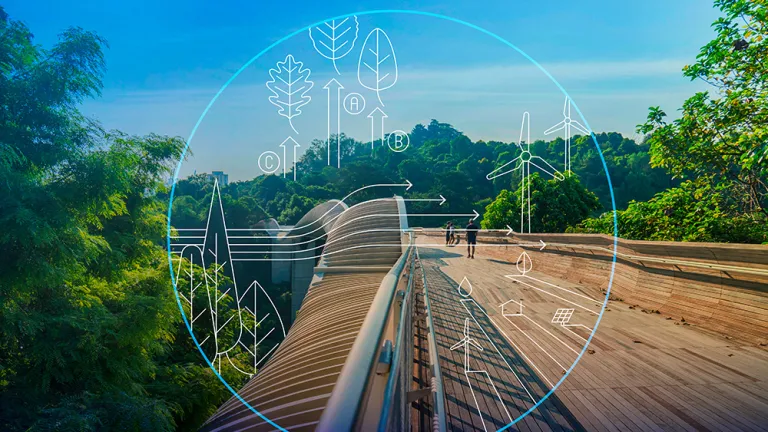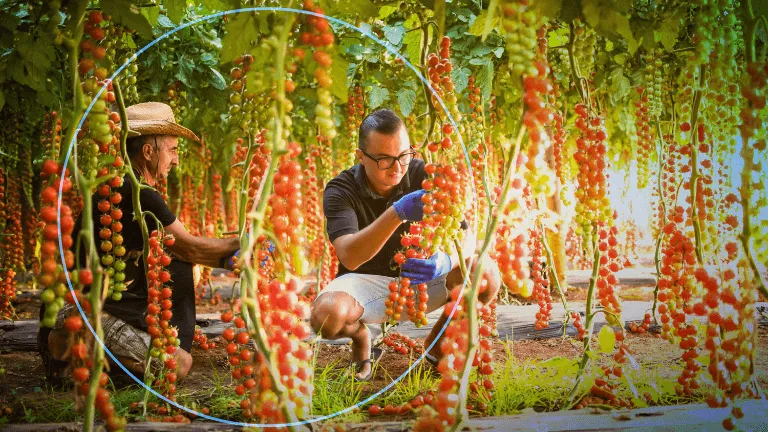Can Technology Help Restore Biodiversity and How?
As biodiversity faces growing threats, can technology truly reshape how we preserve and restore ecosystems through innovative solutions?
EXPERT PERSPECTIVES
Let us dive deeper into what type of technology can drive meaningful change in biodiversity restoration and how, with Dr. Nathanial Matthews, CEO and co-founder of PlanetaryX and a member of the Science Based Targets for Nature (SBTN) Integrity Council, Beth Knight, Senior Associate at the University of Cambridge Institute of Sustainability Leadership (CISL), and Dr. Philippine de T’Serclaes, Chief Sustainability Officer at Dassault Systèmes.
Understanding Biodiversity with Data
Biodiversity encompasses all forms of life in a particular area: the variety of animals, plants, fungi, and microorganisms that make up our natural world. These organisms interact in an intricate ecosystem where balance is essential to sustain it and support life.
Due to this complexity, a thorough and holistic understanding is key for its preservation and even more for its restoration. That understanding requires one crucial ingredient: data.
Technology’s Role in Restoring Biodiversity
This is where technology steps in.
Today, technology and its various forms, plays a vital role in harnessing vast amounts of data by:
- revealing species’ presence and human threats with cameras, soundscapes and eDNA sampling,
- mapping species down to individual plants thanks to drones equipped with LiDAR,
- displaying field-level conservation insights and collaboration opportunities with specialized platforms,
- providing scientifically accurate models of systems-of-systems through virtual twins,
- monitoring deforestation and carbon stocks in near-real-time with satellite imagery and AI,
and more.
These innovations allow us to move beyond observation to data-driven action. Technology has the power to fill data gaps and replace fragmented, incomplete manual surveys, guide targeted actions specifically on tough terrains, help simulate reality with precision, speed up responses and even enable preventive interventions.
Technologies like the virtual twin can go beyond data gathering. By enhancing transparency, ensuring data integrity and quality, and providing metrics for measurement, virtual twins enable informed decision-making. This facilitates collaboration, improves action efficiency, and extends reach and scalability. Collectively, this helps us determine where to act, how to act, and assess what impact we're making. Moreover, virtual twins are now evolving to model complex value networks—helping businesses understand and address upstream, midstream and downstream impacts.
But is Technology Always the Answer?
Skepticism around technology’s role and capabilities in preserving and restoring biodiversity is understandable.
“Historically,” says Dr. Nathanial Matthews, “technology has prioritized short-term economic gains and excluded communities from benefits.” Echoing this, Beth Knight notes that in the age of AI, “technology can be a double-edge sword, both saving the ecosystems and straining them.” For example, in its latest report on Energy and AI, the International Energy Agency states that the widespread adoption of existing AI applications could lead to emissions reductions that are far larger than emissions from AI-focused data centers, provided managed properly.
However, technology itself is neutral—its impact depends on how it’s developed and applied.
As a member of the Coalition for Sustainable Artificial Intelligence, Dassault Systèmes is committed to harnessing the power of AI to support environmental sustainability—from decarbonizing economies and reducing pollution to preserving biodiversity and protecting our oceans. “Dassault Systèmes' 3D UNIV+RSES, empower organizations to imagine and create solutions that enable the Generative Economy and help actors think about solutions that optimize resource consumption” adds Dr. Philippine de T’Serclaes.
Indeed, while technology can help restore biodiversity, its own footprint must be considered. Sustainable technology deployment—including circular design principles for hardware, use of renewable energy in data centers, and reductions in water usage—is vital to ensure that the cure isn’t contributing to the problem.
Beyond Tools: Tech with People and Purpose
To truly benefit biodiversity, technology alone isn’t enough. "Technology helps us overcome significant barriers such as lack of transparency, data accuracy, and scalability of preservation actions," notes Dr. Nathanial Matthews from PlanetaryX. "However, technology alone is not a panacea; it’s a means, not an end. Its insights must be combined with local knowledge through community engagement, and its use must be robustly and transparently governed. It must also enable scalability."
Indeed, “local initiatives often yield strong results but lack scale, while global plans can falter without local adaptation” confirms Beth Knight. “Technology bridges this gap, operating at both macro and micro levels.”
In that context, virtual twins are uniquely positioned to tackle highly complex challenges, like biodiversity preservation, where every element of the ecosystem matters. “Virtual twins provide a holistic view of global interactions,” says Dr. Philippine de T’Serclaes” and allow navigation across different scales. Powered by contextualized data, they enable organizations to model and simulate from the micro to the macro level with scientific accuracy, helping them understand how each layer affects the larger issue.”
Other technology such as blockchain and smart contracts are also key. The first provides transparent, tamper-proof records of data ensuring integrity while the second delivers funds directly to the guardians and stewards of the ecosystems. For example, at PlanetaryX, Ecosystem Resilience Assets (E.R.A.s) use these technologies to ensure integrity in markets, speed and scale of deployment, and to reward and incentivize the efforts of ecosystem guardians.
How to Integrate Technology Meaningfully?
Drivers of success
Prioritizing Biodiversity: Biodiversity should be a core driver of business strategy and not just a byproduct. By making biodiversity restoration a measurable outcome of a company's operations, organizations can better justify and engage investments in technologies that support biodiversity as well as ensure those technologies are used with restoration and regeneration in mind. In fact, when biodiversity regeneration is integrated into operational goals and supported by technology, it creates both environmental value and new business opportunities. Indeed, the World Economic Forum estimates that businesses acting to preserve biodiversity could unlock $10 trillion in new opportunities by 2030.
Purpose-driven: A purpose-driven organization operates with an objective that goes beyond simply generating profit. Organizations need to be committed to sustainability prioritizing areas of value such as biodiversity and be willing to transform and rethink current and inefficient systems to achieve their purpose. Indeed, layering new technology on existing processes can be ineffective: business models must also evolve to protect and regenerate biodiversity.
At Dassault Systèmes, our purpose is to harmonize product, nature, and life: a vision that shapes our strategy, drives our innovation, and guides every customer partnership. We strive to make sustainability not just desirable, but achievable, scalable, and profitable.
Community Engagement: To enhance the effectiveness of biodiversity preservation strategies, organizations need to combine technology with local practices to facilitate shared value with communities and make sure decision-making is transparent and decentralized. This also means embedding trust—by ensuring that technology is co-developed with communities and respects local knowledge.
Technology works best when ecologists, engineers, and communities co-create solutions. Tech alone? It’s just noise. Tech plus trust? That’s transformation.
Collaboration: Technology becomes transformative when combined with collaboration across value networks. Behind every tool are people who must be genuinely committed to sustainability and see biodiversity as vital. Only then can we turn innovation into action.
Strategies to Implement Nature-Positive Technology
To implement technology in ways that support biodiversity, companies must first embrace complexity. Biodiversity is not linear; it is a system of systems and addressing one part often influences other parts. Solutions must reflect this interconnectedness.
With that context in mind, the following strategies are recommended:
- Map Your Impact: Use existing and credible frameworks like those from the Science Based Targets Network (SBTN) to assess how and where your operations intersect with biodiversity. Focus not only on compliance and reputational gains but genuine environmental impact.
- Set Clear Targets: Define specific and realistic objectives focused on measurable and verifiable outcomes.
- Embrace Relevant Solutions: Implement technologies to gather data and assess progress with precision.
- Measure Results: Use indicators to track the effectiveness of interventions and adjust strategies accordingly.

Circularity and Biodiversity
Implementing circular economy practices is pivotal for biodiversity preservation and restoration. Indeed, approximately 90% of biodiversity loss stems from resource extraction and processing at the beginning of the value chain. By integrating circular economy principles (such as designing for durability, reusability, and recyclability) businesses can minimize their dependence on virgin raw materials, thereby reducing habitat destruction and ecosystem degradation and waste, increasing efficiency and extending product lifespans. Virtual twins model every stage of the life cycle and help companies implement circular principles where they have the most impact.
Companies and markets are rapidly awakening to nature risks and ecosystem services as essential infrastructure critical to their long-term success. To address these risks and value ecosystems, they should approach biodiversity and ecosystem service technology with clarity about their objectives, focusing not just on compliance or reputational gains, but genuine environmental impact. In short, protecting and valuing nature is the smartest long-term business strategy.
In conclusion, while technology is not a standalone solution, its thoughtful application—combined with community engagement and a clear purpose—can significantly contribute to biodiversity restoration. By breaking barriers, unlocking new possibilities, and fostering collaboration, technology serves as a powerful tool in our collective effort to preserve the planet's rich biodiversity.
CONTRIBUTORS








